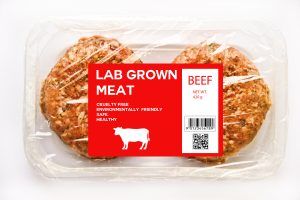Unveiling Lab-Grown Meat
Unveiling Lab-Grown Meat
With its approval for sale in the US last November, lab-grown meat is being hailed in the mainstream media as a solution to global hunger while reducing the environmental impact of traditional animal farming. (Lab-grown chicken was later approved in March.) But what if it isn’t safe, and what if its carbon footprint exceeds that of grass-fed animals?
How They Do It
Lab-grown meat is created by cultivating animal cells in a controlled environment. While the appeal of being able to eat meat without actually having to kill animals may be compelling, the environmental, ethical, and nutritional claims shake out to be lacking in substance. You really don’t want to know how this sausage is made. (Unless you do; then watch this clip of Stephanie Seneff, PhD., On The New MDS explaining the process.
Raising Questions
The use of growth factors, media, and scaffolding materials in the lab-grown meat production process raises questions about the possible accumulation of toxins. These questions have not been addressed with long-term testing. For example, some of the same concerns surrounding Impossible meatless products also apply to this new generation of fake meat. Studies have shown statistically significant changes in the blood that can indicate the onset of inflammation or kidney disease and possible signs of anemia in the rats who consumed the Impossible “meat.”
The process of growing this new meat culture in a lab itself relies on genetic engineering. This is much like gene-editing techniques that involve the deliberate alteration of the genetic makeup of real food. However, this cultured “meat” is not regulated as a genetically modified food (GM).
A New Kind of Immortality
Specifically, the GM concern here is that in nature, a cell’s ability to replicate is limited. Genetic engineering of the cells increases their ability to replicate. And it can even make the cells “immortal” so that they can replicate over and over again. One of the lab meat producing companies, UPSIDE Foods (formerly called Memphis Meats), owns a specific patent. This patent details a way to use CRISPR gene-editing to allow animal cells to replicate indefinitely, exhibiting some of the characteristics of cancerous cells. Logic dictates that eating lab-grown meat could involve ingesting cancer-like cells. Currently, there is no long-term research on the potential cancer risks associated with eating this type of “food.”
Cost Effective?
Due to the costs of chemicals and substances such as fetal bovine serum (FBS) involved in the production—so much for the cruelty-free aspirations—the economic viability of lab-grown meat is not likely to be a reality. Just one pound of lab-grown meat would cost around $40 per pound at the grocery store. According to David Humbird, DWH Process Consulting, “The Capital‐ and operating‐cost analyses of conceptual cell‐mass production facilities indicate economics that would likely preclude the affordability of their products as food.”
But wouldn’t addressing climate change, as we’re told lab meat achieves, be worth the cost?
Not So Friendly
So far, this lab-cultured meat turns out to be no more environmentally friendly than its industrialized meat counterpart. Unfortunately, the factory farms industry couldn’t be further from the regenerative agricultural practices MAA pushes them to adopt. In fact, a recent study from the University of California, Davis, found that lab-grown meat’s carbon footprint is potentially greater than retail beef.
Sustainably-raised livestock and associated pasturing, on the other hand, actually help sequester carbon in the soil. Keeping carbon in the soil is vital for soil health, water management, biodiversity conservation, and sustainable agriculture. It is an essential component of efforts to mitigate greenhouse gas emissions, promote ecosystem resilience, and build a more sustainable future.
Curious about who’s behind lab-grown meat? Read the rest of the article at Moms Across America.
Written by Angela Braden.
Reprinted with Permission from Moms Across America.
- SHARE THIS POST



